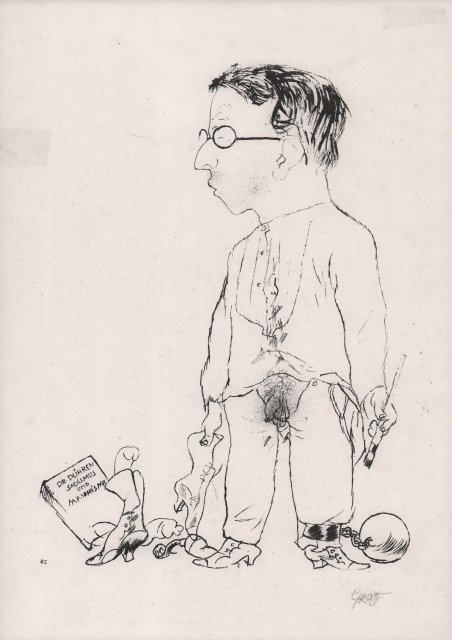Litografia originale di George Grosz, tavola 42 dell’Ecce Homo. La prima, grande raccolta di opere dell'artista George Grosz, pubblicazione che valse a lui e ai suoi editori un processo per aver pubblicato immagini oscene, a seguito della quale parte delle tavole venne confiscata. Da un'edizione di 40 esemplari, firmata a matita da George Grosz in basso a destra. ' Una bella impressione, stampata su carta coeva, qualche ossidazione, altrimenti in ottime condizioni. "Ecce Homo", pubblicato dal Malik Verlag in cinque diverse edizioni nel periodo 1922/1923, è un compendio selezionato di disegni di Grosz dal 1915 al 1922: critico del loro tempo e della società, graffiante e satirico. La grande edizione totale degli acquerelli e dei disegni (10 000 copie) replicati in un processo di riproduzione meticoloso doveva garantire la loro distribuzione di massa. Come sottolinea Alexander Dückers, l'opera disegnata di George Grosz è difficilmente separabile dalla sua opera stampata, ed è assolutamente caratteristico che, dopo il 1918, in linea con il suo concetto "undogmatico", l'artista abbia pubblicato "quasi esclusivamente fotolitografie e stampe offset dopo i disegni, cioè riproduzioni grafiche." (A. Dückers). ' L'artista e gli editori Julian Gumperz e Wieland Herzfelde furono processati nel 1923/1924 perché "Ecce Homo" conteneva numerosi fogli che offendevano "il senso di vergogna e decenza di una persona con normali percezioni in materia di sessualità" - come si legge nelle accuse. "Tuttavia, il tribunale non ha acconsentito alla richiesta dell'accusa di confiscare e distruggere l'intero portfolio di "Ecce Homo". Ha stabilito solo che 17 degli 84 disegni e cinque delle 16 riproduzioni di acquerelli dovevano essere rimossi dall'opera". George Grosz, nome d'arte di Georg Ehrenfried Groß (Berlino, 26 luglio 1893 - Berlino, 6 luglio 1959), è stato un pittore tedesco. Tra il 1909 e il 1911 studiò all'Accademia di Dresda, con l'intenzione di comprendere a fondo le tecniche di rappresentazione degli autori classici. Realizzò copie di opere degli antichi maestri, soprattutto Rubens, esposte nella pinacoteca di Dresda; in questo periodo eseguì anche disegni per giornali e riviste satiriche, utilizzando lo strumento della caricatura. Nel 1913 soggiornò a Parigi, dove entrò in contatto con le avanguardie del cubismo e del futurismo e dove poté ammirare le opere di Francisco Goya, Honoré Daumier e Henri de Toulouse-Lautrec. Fu in questi anni che il suo stile subì un processo di progressiva semplificazione delle forme, sotto l'influenza dell'espressionismo, del cubismo e del futurismo, diffuso tra i giovani artisti dell'epoca. Bibliografia A. Dückers, ' George Grosz, das druckgraphische Werk ' p.72-85; Wieland Herzfelde (introduction), ' Der Malik-Verlag, 1916-1947, ' exhib. cat. Deutsche Akademie der Künste Berlin, Berlin (Ost) 1966, cat. no. 59; Lothar Lang, George-Grosz-Bibliographie, in: Marginalien, Zeitschrfit für Buchkunst und Bibliophilie, 30th issue, July 1968, p. 1 ff, no. 38; Rosamunde Neugebauer, Georges Grosz, Macht und Ohnmacht satirischer Kunst. Die Graphikfolgen "Gott mit uns", Ecce Homo und Hintergrund, Berlin 1993, p. 81 ff. Original lithograph by George Grosz, plate 42 from ' Ecce Homo. ' From an edition of 40, signed in pencil by George Grosz. At lower right. A fine impression, printed on contemporary wove paper, some foxing, otherwise very good condition. ' “Ecce Homo”, published by the Malik Verlag in five different editions during the weeks of the turn of year 1922/1923, is a selected compendium of drawings by Grosz from 1915 to 1922: critical of their time and society, biting and satirical. The large total edition of the watercolours and drawings (10 000 copies) replicated in a meticulous reproduction process was meant to guarantee their mass distribution. As Alexander Dückers emphasises, George Grosz's drawn work is hardly to be divided from his printed work, and it is downright characteristic that, after 1918, in keeping with his “undogmatic” concept, the artist published “almost exclusively photolithographs and offset prints after drawings, that is, graphic reproductions” (A. Dückers). The artist and the publishers Julian Gumperz and Wieland Herzfelde were put on trial in 1923/1924 because “Ecce Homo” contained numerous sheets that offended “the sense of shame and decency of a person with normal perceptions in regard to sexuality” - as stated in the charges. “However, the court did not consent to the prosecution's claim that the entire 'Ecce Homo' portfolio be confiscated and destroyed. It determined only that 17 of the 84 drawings and five of the 16 reproductions of watercolours were to be removed from the work.” George Grosz, stage name of Georg Ehrenfried Groß (Berlin, July 26, 1893 - Berlin, July 6, 1959), was a German painter. Between 1909 and 1911 he studied at the Academy of Dresden, with the intention of fully understanding the techniques of representation of classical authors. He made copies of works by the old masters, especially Rubens, exhibited in the Dresden picture gallery, in this period also performed drawings for newspapers and satirical magazines, using the tool of caricature. In 1913 he stayed in Paris, where he came into contact with the avant-garde of Cubism and Futurism and where he could admire the works of Francisco Goya, Honoré Daumier and Henri de Toulouse-Lautrec. It was in these years that his style underwent a process of progressive simplification of forms, under the influence of expressionism, cubism and futurism, widespread among the young artists of the time. Literature A. Dückers, ' George Grosz, das druckgraphische Werk ' p.72-85; Wieland Herzfelde (introduction), ' Der Malik-Verlag, 1916-1947, ' exhib. cat. Deutsche Akademie der Künste Berlin, Berlin (Ost) 1966, cat. no. 59; Lothar Lang, George-Grosz-Bibliographie, in: Marginalien, Zeitschrfit für Buchkunst und Bibliophilie, 30th issue, July 1968, p. 1 ff, no. 38; Rosamunde Neugebauer, Georges Grosz, Macht und Ohnmacht satirischer Kunst. Die Graphikfolgen "Gott mit uns", Ecce Homo und Hintergrund, Berlin 1993, p. 81 ff. Cfr.

Find out how to use
Find out how to use

